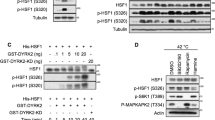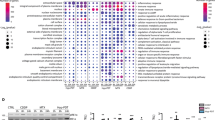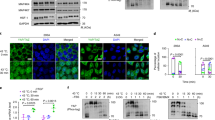Abstract
Nuclear factor-κB (NF-κB) is involved in multiple aspects of oncogenesis and controls cancer cell survival by promoting anti-apoptotic gene expression. The constitutive activation of NF-κB in several types of cancers, including hematological malignancies, has been implicated in the resistance to chemo- and radiation therapy. We have previously reported that cytokine- or virus-induced NF-κB activation is inhibited by chemical and physical inducers of the heat shock response (HSR). In this study we show that heat stress inhibits constitutive NF-κB DNA-binding activity in different types of B-cell malignancies, including multiple myeloma, activated B-cell-like (ABC) type of diffuse large B-cell lymphoma (DLBCL) and Burkitt's lymphoma presenting aberrant NF-κB regulation. Heat-induced NF-κB inhibition leads to rapid downregulation of the anti-apoptotic protein cellular inhibitor-of-apoptosis protein 2 (cIAP-2), followed by activation of caspase-3 and cleavage of the caspase-3 substrate poly(adenosine diphosphate ribose)polymerase (PARP), causing massive apoptosis under conditions that do not affect viability in cells not presenting NF-κB aberrations. NF-κB inhibition by the proteasome inhibitor bortezomib and by short-hairpin RNA (shRNA) interference results in increased sensitivity of HS-Sultan B-cell lymphoma to hyperthermic stress. Altogether, the results indicate that aggressive B-cell malignancies presenting constitutive NF-κB activity are sensitive to heat-induced apoptosis, and suggest that aberrant NF-κB regulation may be a marker of heat stress sensitivity in cancer cells.
This is a preview of subscription content, access via your institution
Access options
Subscribe to this journal
Receive 12 print issues and online access
$259.00 per year
only $21.58 per issue
Buy this article
- Purchase on Springer Link
- Instant access to full article PDF
Prices may be subject to local taxes which are calculated during checkout






Similar content being viewed by others
References
Li Q, Verma I . NF-kappaB regulation in the immune system. Nat Rev Immunol 2002; 2: 725–734.
Santoro MG, Rossi A, Amici C . NF-kappaB and virus infection: who controls whom. EMBO J 2003; 22: 2552–2560.
Karin M, Lin A . NF-kappaB at the crossroads of life and death. Nat Immunol 2002; 3: 221–227.
Bonizzi G, Karin M . The two NF-kappaB activation pathways and their role in innate and adaptive immunity. Trends Immunol 2004; 25: 280–288.
Karin M . Nuclear factor-kappaB in cancer development and progression. Nature 2006; 441: 431–436.
Rayet B, Gelinas C . Aberrant rel/nfkb genes and activity in human cancer. Oncogene 1999; 18: 6938–6947.
Baldwin Jr AS . The transcription factor NF-kappaB and human disease. J Clin Invest 2001; 107: 3–6.
Ni H, Ergin M, Huang Q, Qin JZ, Amin HM, Martinez RL et al. Analysis of expression of nuclear factor kappa B (NF-kappa B) in multiple myeloma: downregulation of NF-kappa B induces apoptosis. Br J Haematol 2001; 115: 279–286.
Bargou RC, Emmerich F, Krappmann D, Bommert K, Mapara MY, Arnold W et al. Constitutive nuclear factor-kappaB-RelA activation is required for proliferation and survival of Hodgkin's disease tumor cells. J Clin Invest 1997; 100: 2961–2969.
Pham LV, Tamayo A, Yoshimura LC, Lo P, Terry N, Reid PS et al. A CD40 signalosome anchored in lipid rafts leads to constitutive activation of NF-kappaB and autonomous cell growth in B cell lymphomas. Immunity 2002; 16: 37–50.
Davis RE, Brown KD, Siebenlist U, Staudt LM . Constitutive nuclear factor kappaB activity is required for survival of activated B cell-like diffuse large B cell lymphoma cells. J Exp Med 2001; 194: 1861–1874.
Orlowski RZ, Eswara JR, Lafond-Walker A, Grever MR, Orlowski M, Dang CV . Tumor growth inhibition induced in a murine model of human Burkitt's lymphoma by a proteasome inhibitor. Cancer Res 1998; 58: 4342–4348.
Rossi A, Elia G, Santoro MG . Inhibition of nuclear factor kappa B by prostaglandin A1: an effect associated with heat shock transcription factor activation. Proc Natl Acad Sci USA 1997; 94: 746–750.
Morimoto RI . Regulation of the heat shock transcriptional response: cross talk between a family of heat shock factors, molecular chaperones, and negative regulators. Genes Dev 1998; 12: 3788–3796.
Jolly C, Morimoto RI . Role of the heat shock response and molecular chaperones in oncogenesis and cell death. J Natl Cancer Inst 2000; 92: 1564–1572.
Morimoto RI, Santoro MG . Stress-inducible responses and heat shock proteins: new pharmacologic targets for cytoprotection. Nat Biotechnol 1998; 16: 833–838.
Kline MP, Morimoto RI . Repression of the heat shock factor 1 transcriptional activation domain is modulated by constitutive phosphorylation. Mol Cell Biol 1997; 17: 2107–2115.
Pirkkala L, Nykanen P, Sistonen L . Roles of the heat shock transcription factors in regulation of the heat shock response and beyond. FASEB J 2001; 15: 1118–1131.
Anckar J, Sistonen L . Heat shock factor 1 as a coordinator of stress and developmental pathways. Adv Exp Med Biol 2007; 594: 78–88.
Takayama S, Reed JC, Homma S . Heat-shock proteins as regulators of apoptosis. Oncogene 2003; 22: 9041–9047.
Rossi A, Elia G, Santoro MG . Activation of the heat shock factor 1 by serine protease inhibitors. An effect associated with nuclear factor-kappaB inhibition. J Biol Chem 1998; 273: 16446–16452.
Amici C, Belardo G, Rossi A, Santoro MG . Activation of I kappa B kinase by herpes simplex virus type 1. A novel target for anti-herpetic therapy. J Biol Chem 2001; 276: 28759–28766.
Piva R, Ruggeri B, Williams M, Costa G, Tamagno I, Ferrero D et al. CEP-18770: a novel, orally active proteasome inhibitor with a tumor-selective pharmacologic profile competitive with bortezomib. Blood 2008; 111: 2765–2775.
Piva R, Gianferretti P, Ciucci A, Taulli R, Belardo G, Santoro MG . 15-deoxy-D12,14-prostaglandin J2 induces apoptosis in human malignant B-cells: an effect associated with inhibition of NF-κB activity and down-regulation of anti-apoptotic proteins. Blood 2005; 105: 1750–1758.
Rossi A, Kapahi P, Natoli G, Takahashi T, Chen Y, Karin M et al. Anti-inflammatory cyclopentenone prostaglandins are direct inhibitors of IkappaB kinase. Nature 2000; 403: 103–108.
Mosser DD, Theodorakis NG, Morimoto RI . Coordinate changes in heat shock element-binding activity and HSP70 gene transcription rates in human cells. Mol Cell Biol 1988; 8: 4736–4744.
Ciucci A, Gianferretti P, Piva R, Guyot T, Snape TJ, Roberts SM et al. Induction of apoptosis in estrogen receptor-negative breast cancer cells by natural and synthetic cyclopentenones: role of the IkappaB kinase/nuclear factor-kappaB pathway. Mol Pharmacol 2006; 70: 1812–1821.
Kanda K, Hu HM, Zhang L, Grandchamps J, Boxer LM . NF-kappaB activity is required for the deregulation of c-myc expression by the immunoglobulin heavy chain enhancer. J Biol Chem 2000; 275: 32338–32346.
Wu C . Heat shock transcription factors: structure and regulation. Annu Rev Cell Dev Biol 1995; 11: 441–469.
Hildebrandt B, Wust P, Ahlers O, Dieing A, Sreenivasa G, Kerner T et al. The cellular and molecular basis of hyperthermia. Crit Rev Oncol Hematol 2002; 43: 33–56.
Dave SS, Fu K, Wright GW, Lam LT, Kluin P, Boerma EJ et al. Molecular diagnosis of Burkitt's lymphoma. N Engl J Med 2006; 354: 2431–2442.
Hummel M, Bentink S, Berger H, Klapper W, Wessendorf S, Barth TF et al. A biologic definition of Burkitt's lymphoma from transcriptional and genomic profiling. N Engl J Med 2006; 354: 2419–2430.
Ngo VN, Davis RE, Lamy L, Yu X, Zhao H, Lenz G et al. A loss-of-function RNA interference screen for molecular targets in cancer. Nature 2006; 441: 106–110.
Santoro MG . Heat shock factors and the control of the stress response. Biochem Pharmacol 2000; 59: 55–63.
Ran R, Lu A, Zhang L, Tang Y, Zhu H, Xu H et al. Hsp70 promotes TNF-mediated apoptosis by binding IKK gamma and impairing NF-kappa B survival signaling. Genes Dev 2004; 18: 1466–1481.
Frelin C, Imbert V, Bottero V, Gonthier N, Samraj AK, Schulze-Osthoff K et al. Inhibition of the NF-kappaB survival pathway via caspase-dependent cleavage of the IKK complex scaffold protein and NF-kappaB essential modulator NEMO. Cell Death Differ 2008; 1: 152–160.
Vaux DL, Silke J . IAPs, RINGs and ubiquitylation. Nat Rev Mol Cell Biol 2005; 6: 287–297.
Dürkop H, Hirsh B, Hahn C, Stein H . cIAP2 is highly expressed in Hodgkin-Reed-Sternberg cells and inhibits apoptosis by interfering with constitutively active caspase-3. J Mol Med 2006; 84: 132–141.
Varfolomeev E, Blankenship JW, Wayson SM, Fedorova AV, Kayagaki N, Garg P et al. IAP antagonists induce autoubiquitination of c-IAPs, NF-kappaB activation, and TNFalpha-dependent apoptosis. Cell 2007; 131: 669–681.
Kashkar H, Haefs C, Shin H, Hamilton-Dutoit SJ, Salvesen GS, Kronke M et al. XIAP-mediated caspase inhibition in Hodgkin's lymphoma–derived B cells. J Exp Med 2003; 198: 341–347.
Ghosh S . Regulation of inducible gene expression by the transcription factor NF-kappaB. Immunol Res 1999; 19: 183–189.
Hideshima T, Richardson P, Chauhan D, Palombella VJ, Elliott PJ, Adams J et al. The proteasome inhibitor PS-341 inhibits growth, induces apoptosis, and overcomes drug resistance in human multiple myeloma cells. Cancer Res 2001; 61: 3071–3076.
Beere HM . Death versus survival: functional interaction between the apoptotic and stress-inducible heat shock protein pathways. J Clin Invest 2005; 115: 2633–2639.
Mosser DD, Morimoto RI . Molecular chaperones and the stress of oncogenesis. Oncogene 2004; 23: 2907–2918.
Westerheide SD, Kawahara TL, Orton K, Morimoto RI . Triptolide, an inhibitor of the human heat shock response that enhances stress-induced cell death. J Biol Chem 2006; 281: 9616–9622.
Zaarur N, Gabai V, Porco JA, Calderwood S, Sherman MY . Targeting heat shock response to sensitize cancer cells to proteasome and Hsp90 inhibitors. Cancer Res 2006; 66: 1783–1791.
Rossi A, Ciafrè S, Balsamo M, Pierimarchi P, Santoro MG . Targeting the heat shock factor 1 by RNA interference: a potent tool to enhance hyperthermochemotherapy efficacy in cervical cancer. Cancer Res 2006; 66: 7678–7685.
Wust P, Hildebrandt B, Sreenivasa G, Rau B, Gellermann J, Riess H et al. Hyperthermia in combined treatment of cancer. Lancet Oncol 2002; 3: 487–497.
Takahashi I, Emi Y, Hasuda S, Kakeji Y, Maehara Y, Sugimachi K . Clinical application of hyperthermia combined with anticancer drugs for the treatment of solid tumors. Surgery 2002; 131: S48–S54.
Mitsiades N, Mitsiades CS, Poulaki V, Chauhan D, Richardson PG, Hideshima T et al. Biologic sequelae of nuclear factor-kappaB blockade in multiple myeloma: therapeutic applications. Blood 2002; 99: 4079–4086.
Acknowledgements
This work was supported by the Italian Ministry of University and Scientific Research (MIUR), the Italian Ministry of Public Health (ISS projects Lotta ai Tumori), the EU EICOSANOX project and Regione Piemonte (A361 Project). We thank Dr Cristina Ferreri for technical help.
Author information
Authors and Affiliations
Corresponding author
Additional information
Supplementary Information accompanies the paper on the Leukemia website (http://www.nature.com/leu)
Rights and permissions
About this article
Cite this article
Belardo, G., Piva, R. & Santoro, M. Heat stress triggers apoptosis by impairing NF-κB survival signaling in malignant B cells. Leukemia 24, 187–196 (2010). https://doi.org/10.1038/leu.2009.227
Received:
Revised:
Accepted:
Published:
Issue Date:
DOI: https://doi.org/10.1038/leu.2009.227
Keywords
This article is cited by
-
Acute exercise boosts cell proliferation and the heat shock response in lymphocytes: correlation with cytokine production and extracellular-to-intracellular HSP70 ratio
Cell Stress and Chaperones (2017)
-
Global gene expression changes of in vitro stimulated human transformed germinal centre B cells as surrogate for oncogenic pathway activation in individual aggressive B cell lymphomas
Cell Communication and Signaling (2012)
-
New developments in the pathology of malignant lymphoma: a review of the literature published from October 2009 to January 2010
Journal of Hematopathology (2010)



